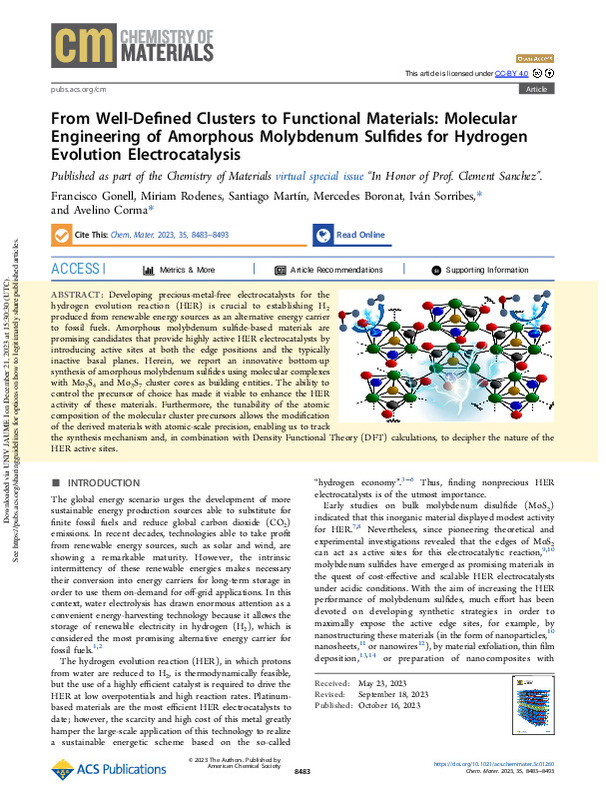JavaScript is disabled for your browser. Some features of this site may not work without it.
Buscar en RiuNet
Listar
Mi cuenta
Estadísticas
Ayuda RiuNet
Admin. UPV
From Well-Defined Clusters to Functional Materials: Molecular Engineering of Amorphous Molybdenum Sulfides for Hydrogen Evolution Electrocatalysis
Mostrar el registro sencillo del ítem
Ficheros en el ítem
| dc.contributor.author | Gonell-Gómez, Francisco
|
es_ES |
| dc.contributor.author | Rodenes-Carrillo, Miriam
|
es_ES |
| dc.contributor.author | Martín, Santiago
|
es_ES |
| dc.contributor.author | Boronat Zaragoza, Mercedes
|
es_ES |
| dc.contributor.author | Sorribes-Terrés, Iván
|
es_ES |
| dc.contributor.author | Corma Canós, Avelino
|
es_ES |
| dc.date.accessioned | 2023-12-26T19:02:45Z | |
| dc.date.available | 2023-12-26T19:02:45Z | |
| dc.date.issued | 2023-10-16 | es_ES |
| dc.identifier.issn | 0897-4756 | es_ES |
| dc.identifier.uri | http://hdl.handle.net/10251/201123 | |
| dc.description.abstract | [EN] Developing precious-metal-free electrocatalysts for the hydrogen evolution reaction (HER) is crucial to establishing H-2 produced from renewable energy sources as an alternative energy carrier to fossil fuels. Amorphous molybdenum sulfide-based materials are promising candidates that provide highly active HER electrocatalysts by introducing active sites at both the edge positions and the typically inactive basal planes. Herein, we report an innovative bottom-up synthesis of amorphous molybdenum sulfides using molecular complexes with Mo3S4 and Mo3S7 cluster cores as building entities. The ability to control the precursor of choice has made it viable to enhance the HER activity of these materials. Furthermore, the tunability of the atomic composition of the molecular cluster precursors allows the modification of the derived materials with atomic-scale precision, enabling us to track the synthesis mechanism and, in combination with Density Functional Theory (DFT) calculations, to decipher the nature of the HER active sites. | es_ES |
| dc.description.sponsorship | This work has been supported by the Gen-T Plan of the Generalitat Valenciana through the programs "Subvencions a l'Excellencia Cientifica de Juniors Investigadors" (SEJI/2020/ 018) and "Investigadors Doctors d'Exellencia" (CIDEXG/ 2022/22). Financial support by Severo Ochoa centre of excellence program (CEX2021-001230-S) is gratefully acknowledged. S.M. thanks DGA/fondos FEDER (construyendo Europa desde Aragon) for funding the research group Platon (E31_20R). M.R. and F.G. acknowledge the Vice-Rectorate for Research, Innovation and Transfer of the Universitat Politecnica de Valencia (UPV) for a pre- and postdoctoral (PAID-10-20) fellowship, respectively. The authors also thank the Electron Microscopy Service of the UPV for TEM facilities and Dr. G. Antorrena for technical support in XPS studies. | es_ES |
| dc.language | Inglés | es_ES |
| dc.publisher | American Chemical Society | es_ES |
| dc.relation.ispartof | Chemistry of Materials | es_ES |
| dc.rights | Reconocimiento (by) | es_ES |
| dc.title | From Well-Defined Clusters to Functional Materials: Molecular Engineering of Amorphous Molybdenum Sulfides for Hydrogen Evolution Electrocatalysis | es_ES |
| dc.type | Artículo | es_ES |
| dc.identifier.doi | 10.1021/acs.chemmater.3c01260 | es_ES |
| dc.relation.projectID | info:eu-repo/grantAgreement/GENERALITAT VALENCIANA//CIDEXG%2F2022%2F22//Molecularly engineering defective basal planes of molybdenum and tungsten chalcogenides-based nanomaterials for energy conversion and storage/ | es_ES |
| dc.relation.projectID | info:eu-repo/grantAgreement/UPV//PAID-10-20/ | es_ES |
| dc.relation.projectID | info:eu-repo/grantAgreement/FEDER//E31_20R/ | es_ES |
| dc.relation.projectID | info:eu-repo/grantAgreement/GVA//SEJI%2F2020%2F018//Subvencions a l Excel· lencia Científica de Juniors Investigadors/ | es_ES |
| dc.relation.projectID | info:eu-repo/grantAgreement/MICINN//CEX2021-001230-S/ | es_ES |
| dc.rights.accessRights | Abierto | es_ES |
| dc.contributor.affiliation | Universitat Politècnica de València. Instituto Universitario Mixto de Tecnología Química - Institut Universitari Mixt de Tecnologia Química | es_ES |
| dc.description.bibliographicCitation | Gonell-Gómez, F.; Rodenes-Carrillo, M.; Martín, S.; Boronat Zaragoza, M.; Sorribes-Terrés, I.; Corma Canós, A. (2023). From Well-Defined Clusters to Functional Materials: Molecular Engineering of Amorphous Molybdenum Sulfides for Hydrogen Evolution Electrocatalysis. Chemistry of Materials. 35(20):8483-8493. https://doi.org/10.1021/acs.chemmater.3c01260 | es_ES |
| dc.description.accrualMethod | S | es_ES |
| dc.relation.publisherversion | https://doi.org/10.1021/acs.chemmater.3c01260 | es_ES |
| dc.description.upvformatpinicio | 8483 | es_ES |
| dc.description.upvformatpfin | 8493 | es_ES |
| dc.type.version | info:eu-repo/semantics/publishedVersion | es_ES |
| dc.description.volume | 35 | es_ES |
| dc.description.issue | 20 | es_ES |
| dc.relation.pasarela | S\505897 | es_ES |
| dc.contributor.funder | Gobierno de Aragón | es_ES |
| dc.contributor.funder | GENERALITAT VALENCIANA | es_ES |
| dc.contributor.funder | European Regional Development Fund | es_ES |
| dc.contributor.funder | Ministerio de Ciencia e Innovación | es_ES |
| dc.contributor.funder | Universitat Politècnica de València | es_ES |








